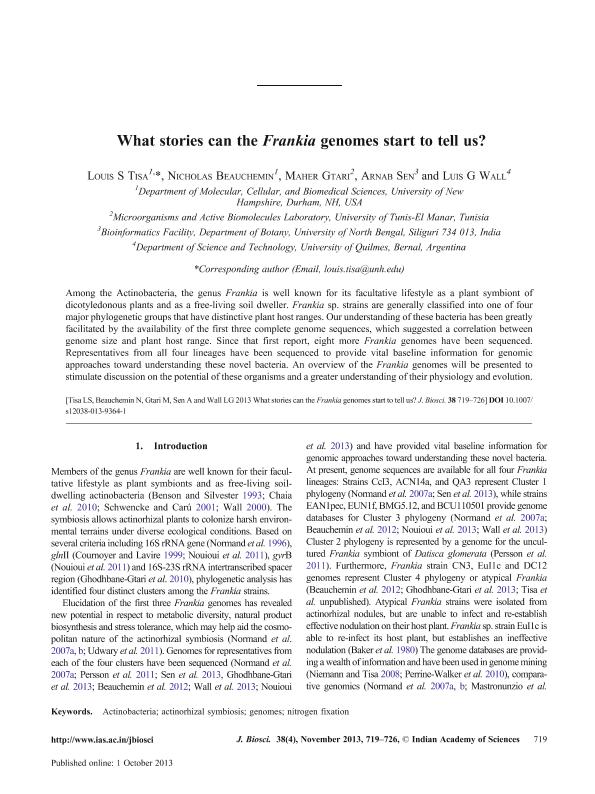Mostrar el registro sencillo del ítem
dc.contributor.author
Tisa, Louis S.
dc.contributor.author
Beauchemin, Nicholas
dc.contributor.author
Gtari, Maher
dc.contributor.author
Sen, Arnab
dc.contributor.author
Wall, Luis Gabriel

dc.date.available
2017-09-08T14:34:12Z
dc.date.issued
2013-11
dc.identifier.citation
Tisa, Louis S.; Beauchemin, Nicholas; Gtari, Maher; Sen, Arnab; Wall, Luis Gabriel; What stories can the Frankia genomes tell us?; Indian Academy of Sciences; Journal of Biosciences; 38; 4; 11-2013; 719-726
dc.identifier.issn
0250-5991
dc.identifier.uri
http://hdl.handle.net/11336/23855
dc.description.abstract
Among the Actinobacteria, the genus Frankia is well known for its facultative lifestyle as a plant symbiont of dicotyledonous plants and as a free-living soil dweller. Frankia sp. strains are generally classified into one of four major phylogenetic groups that have distinctive plant host ranges. Our understanding of these bacteria has been greatly facilitated by the availability of the first three complete genome sequences, which suggested a correlation between genome size and plant host range. Since that first report, eight more Frankia genomes have been sequenced. Representatives from all four lineages have been sequenced to provide vital baseline information for genomic approaches toward understanding these novel bacteria. An overview of the Frankia genomes will be presented to stimulate discussion on the potential of these organisms and a greater understanding of their physiology and evolution.
dc.format
application/pdf
dc.language.iso
eng
dc.publisher
Indian Academy of Sciences

dc.rights
info:eu-repo/semantics/openAccess
dc.rights.uri
https://creativecommons.org/licenses/by-nc-sa/2.5/ar/
dc.subject
Actinobacteria
dc.subject
Actinorhizal Symbiosis
dc.subject
Genomes
dc.subject
Nitrogen Fixation
dc.subject.classification
Bioquímica y Biología Molecular

dc.subject.classification
Ciencias Biológicas

dc.subject.classification
CIENCIAS NATURALES Y EXACTAS

dc.title
What stories can the Frankia genomes tell us?
dc.type
info:eu-repo/semantics/article
dc.type
info:ar-repo/semantics/artículo
dc.type
info:eu-repo/semantics/publishedVersion
dc.date.updated
2017-09-07T16:55:42Z
dc.identifier.eissn
0973-7138
dc.journal.volume
38
dc.journal.number
4
dc.journal.pagination
719-726
dc.journal.pais
India

dc.journal.ciudad
Bangalore
dc.description.fil
Fil: Tisa, Louis S.. University of New Hampshire. Department of Molecular, Cellular, and Biomedical Sciences; Estados Unidos
dc.description.fil
Fil: Beauchemin, Nicholas. University of New Hampshire. Department of Molecular, Cellular, and Biomedical Sciences; Estados Unidos
dc.description.fil
Fil: Gtari, Maher. University of Tunis-El Manar. Laboratory of Microorganisms and Active Biomolecules; Túnez
dc.description.fil
Fil: Sen, Arnab. University of North Bengal. Department of Botany. Bioinformatics Facility; India
dc.description.fil
Fil: Wall, Luis Gabriel. Universidad Nacional de Quilmes. Departamento de Ciencia y Tecnología; Argentina. Consejo Nacional de Investigaciones Científicas y Técnicas; Argentina
dc.journal.title
Journal of Biosciences

dc.relation.alternativeid
info:eu-repo/semantics/altIdentifier/doi/http://www.ias.ac.in/describe/article/jbsc/038/04/0719-0726
dc.relation.alternativeid
info:eu-repo/semantics/altIdentifier/url/https://link.springer.com/article/10.1007%2Fs12038-013-9364-1
dc.relation.alternativeid
info:eu-repo/semantics/altIdentifier/doi/http://dx.doi.org/10.1007/s12038-013-9364-1
Archivos asociados
